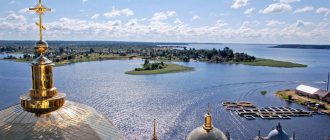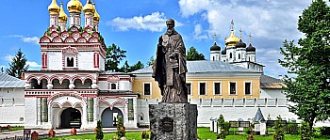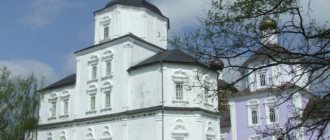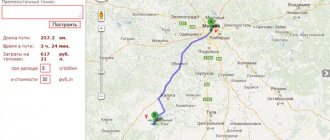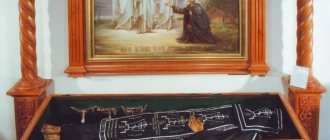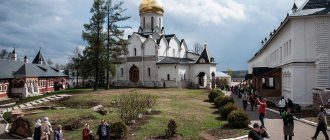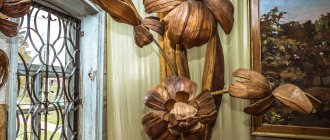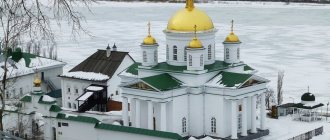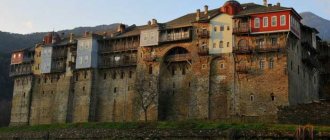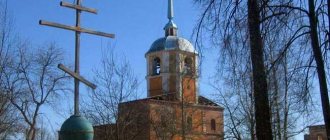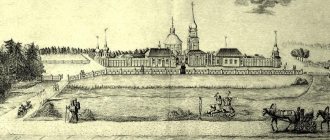Architectural ensemble
On the small plot of land that the monastery occupies, there are many buildings that make up a single ensemble. The architecture of the monastery is not similar to similar buildings in other monasteries. The monastery buildings are painted in warm, rich colors that blend organically with the surrounding landscape and instill a feeling of peace and tranquility.
The main entrance to the territory is the Holy Gate with the gate bell tower located above it. Having passed under the face of St. David, located above the entrance, parishioners find themselves in the inner territory of the monastery, which is fenced by a wall with four towers.
Shrines and relics
The main shrine is kept in the Church of the Sign. Believers come to the relics of St. David of the Ascension to venerate and pray for help. In the same temple is kept the icon of the Most Holy Theotokos “The Sign”, with which the founder of the monastery came to the bank of the Lopasnya River and the ark with 150 particles of the relics of Orthodox saints. In the altar of the temple there is a particle of the Nail with which the Savior was crucified.
Patronal feast of the discovery of the relics of David of Serpukhov in the Ascension David Hermitage
In the Spassky Church there are arks with particles of the robes of Jesus Christ and the Mother of God. St. Nicholas Church contains fragments of the relics of Matrona of Moscow, Sergius of Radonezh, and the apostles Mark, Matthew and Luke.
More than 200 pieces of holy relics are collected in the monastery.
Attention! A full description of all relics can be seen in the official publications of the Holy Ascension David's Hermitage.
Ascension David's Hermitage in New Life.
Published by: Lena 04/26/2012 in Uncategorized, Short trips, Trips with children |
Ascension David's Monastery is a monastery located on the high right bank of the Lopasnya River (a tributary of the Oka River), next to the current village of Novy Byt, Chekhov district, Moscow region.
Founded on May 31 (June 10), 1515 by the Monk David (†September 19 (29), 1529), which was recorded in the monastery synodikon of 1602, however, due to some inconsistencies in the record, the indicated founding date raises doubts about its authenticity.
The Monk David, according to legend, came from the family of the princes of Vyazemsky and bore the name Daniel in the world. While still a young man, he felt a calling to the ascetic life and came to the Paphnutian Borovsky Monastery. At that time, the founder of the monastery, the Monk Paphnutius Borovsky, was still alive.
The Monk Sergius of Radonezh, the abbot of the Russian land, was the teacher of the Monk Nikita, the third abbot of the Serpukhov Vysotsky Monastery. The Monk Paphnutius was tonsured and a disciple of the Monk Nikita, and young Daniel became a disciple and tonsured by the Monk Paphnutius and was named David in honor of the Monk David of Thessalonica, a holy hermit who lived in the 6th century. Thus, the Monk David became the successor to the covenants of the Monk Sergius and an active representative of his monastic school.
In 1515, the Monk David left the Borovsky monastery to found his own monastery in a desert area. He chose a place that belonged to Prince Vasily Semenovich Starodubsky, on the banks of the Lopasnya River in the ancient Khutyn volost, where he came with the icon of the Sign of the Mother of God with two monks and two novices.
Having settled here, he set up cells and erected the first wooden churches in honor of the Ascension of the Lord God and Savior Jesus Christ. The monk planted a linden grove near his desert.
The veneration of St. David began soon after his death.
The monastery was known to the Russian tsars and members of their families, who did not leave it with their favors. Tsar Ivan the Terrible paid special attention to her. With his funds, the construction of a stone temple began in the monastery.
During troubled times in 1619, the monastery was destroyed by the Lithuanians and Cossacks under the leadership of Hetman Peter Sagaidachny. The activities of the monastery were resumed only on April 1 (10), 1625, when Mikhail Fedorovich issued a charter granting benefits to the monastery.
From 1657 to 1667 The monastery was assigned by Patriarch Nikon to the New Jerusalem Resurrection Monastery. At that time, the treasurer, two hieromonks, five ordinary elders, four servants, a groom, a baker and a belet - a church deacon - lived in the desert.
The last third of the 17th century was the most prosperous time in the history of David’s Desert. The monastery had a courtyard in Moscow on Ordynka Street since 1664, and since 1689 a monastery chapel at the Arbat Gate. Monastic properties were located in Moscow and Kolomensky districts, Serpukhov. For example, in the Moscow district by 1700 the hermitage owned 95 peasant households.
In the 18th century, prosperity gave way to decline. As a result of Peter's reforms, the income of the monasteries went to the state treasury and only part of it was returned to the brethren. In 1764, after the introduction of monastic states, the hermitage became supernumerary, that is, it was maintained at its own expense, but without the possessions taken into the treasury.
In 1792-1796, a communal charter was established in David’s Hermitage. With this innovation the number of brethren increased. By 1915 there were: an archimandrite rector, 18 hieromonks, 7 hierodeacons, 25 monks and about 50 novices.
In the 19th century, new buildings were actively erected and old buildings were renovated in the David Desert.
The last rector before the closure of the monastery was Archimandrite Ilariy (Babykin), a native of the city of Serpukhov.
The monastery was finally closed in October 1929. The brethren of the monastery were partly repressed, partly dispersed.
The abbot's building was taken over as an agricultural technical school. The fraternal buildings housed dormitories for students, and the monastery churches housed garages and warehouses.
A village club was opened in the St. Nicholas Church, a gym in the Assumption Church, and a canteen in the Church of All Saints. A red banner was hoisted on the bell tower.
The large monastery cemetery, where, in addition to monks, lay people were buried (for example, the princes Obolensky and the hero of the war of 1812, General Dokhturov), was destroyed in the mid-50s of the 20th century, the graves were excavated, and the tombstones were used for the foundation of a new college dormitory.
The monastery fence was almost completely destroyed, the domes on the Cathedral, St. Nicholas, Znamensky and All Saints churches were destroyed.
In 1992, residents of the village of Novy Byt formed an Orthodox community, to which the cathedral in the name of the All-Merciful Savior was transferred.
In 1995, on the first Saturday of Great Lent, the first liturgy was celebrated.
On June 1, 1995, the Holy Synod decided to form a monastic community; the previously appointed rector, Hieromonk Herman, was elevated to the rank of abbot.
In 1999, the monastery fence, the domes of the Cathedrals of the All-Merciful Savior and the Ascension of the Lord, St. Nicholas and Znamenskaya churches were almost completely restored at the monastery.
A little later, the bell tower, the refectory church in the name of All Saints, the interiors and iconostases of the temples, and the pond in the middle of the monastery were restored.
On Easter days 2005, the monastery celebrated the 10th anniversary of the revival of monastic life. The restored monastery is the fruit of the ascetic zeal of the brethren, led by the rector, Archimandrite Herman, and the help of many benefactors. It has become a true pearl of the Lopasninsky region.
And already on July 26 of the same year, a misfortune happened: the rector of the Ascension David Hermitage, dean of the churches of the Chekhov district, Archimandrite German, was found murdered in his cell.
Archimandrite German, in the world Khapugin Vyacheslav Nikolaevich, was born on April 30, 1965 in a family of workers. After graduating from high school, he worked at the Orekhovo-Zuevsky sewing association; in 1983-1985 served in the ranks of the Soviet Army.
He began his church activities in 1985 as a psalm reader. In 1987, he took monastic vows with the name Herman in honor of St. Herman of Alaska.
The last time the novices saw the rector was the night before; Father German did not appear at the morning service in the church. But the servants became worried only closer to lunch. After all, the abbot often traveled.
The body of 40-year-old Father Herman, with his hands tied and a traumatic brain injury, was discovered by a novice in the cell of the monastery. Things in the monk's cell were scattered, and the safe, located there, was opened. The killers came to Father Herman in the pre-dawn hour. The criminals tied the priest with an electric wire from a fan, which Father Herman constantly turned on in the cell because of the stuffiness, and tortured him for several hours, breaking his head after they received the key to the safe. The small metal box was empty.
It was not possible to establish how much money the criminals stole because... donations from parishioners were kept in the safe. At the same time, several ancient icons of considerable value hung on the walls of the cell, there were several very expensive gold and silver pectoral crosses, some of which were decorated with diamonds, and in one of the drawers of the murdered man’s desk were five thousand dollars. All this remained untouched, which once again confirms that the target of the raid was a safe, which means there was something very valuable or a huge amount of money lying there.
Two murder suspects emerged two hours after the body was discovered. A 20-year-old former cook of the monastery and a 34-year-old local resident confessed to the murder of Father German. In fact, the two men were detained not for murder, but for looting a corpse. Indeed, on the day of the murder, both men were not far from the crime scene, and one of them seemed to have money that could have been stolen from the treasury. However, it was established that the cook and his friend did not kill Father Herman.
The investigation considered two versions of the crime: robbery and revenge after a personal conflict. The first was supported by the fact that the priest was in charge of the material resources of the monastery. The revenge killing could have been committed by the excommunicated wards of Archimandrite Herman.
The crime remained unsolved.
Father German was buried in the monastery cemetery, behind the altar of St. Nicholas Church. In addition, buried on the territory of the monastery are: Gennady Nedoseka, a criminal authority and part-time head of the Chekhov district, who died under unclear circumstances, shortly before the murder of Father German, and Anton Malevsky, the leader of the famous Izmailovskaya organized crime group and director of a scrap metal melting plant. These people made the largest donations for the restoration of the desert and all did not die a natural death.
On October 6, 2005, Archimandrite Roman (Gavrilov) was appointed rector of the Ascension David Hermitage.
Entrance to the monastery territory.
Panorama of the Ascension David Hermitage.
Bell tower of the Ascension David Hermitage, 1842-1845.
Abbot's corps.
Cathedral of the Ascension of the Lord. Built in 1676-1682 with the help of Patriarch Joachim on the basis of an unfinished temple from the end of the 16th century.
In the background is the Ascension Cathedral. In the foreground is the Church of the Icon of the Mother of God of the Sign - a temple in the pseudo-Russian style, attached to the Ascension Cathedral from the north-west. Built in 1865-1870 under the care of Archimandrite Joseph over the grave of St. David.
Cathedral of the All-Merciful Savior, 1900. A large five-domed temple in the pseudo-Russian style, standing in line with the northern wall of the monastery. Built under the care of Archimandrite Valentin.
Church bench and northwestern tower of the monastery fence.
Church of All Saints, next to the new refectory building, 1899.
Church of St. Nicholas the Wonderworker in the classicist style, attached to the Ascension Cathedral from the north. Built under the care of Abbot Arseny in 1804 on the site of a 17th-century chapel, it served as a winter church.
Church of the Dormition of the Blessed Virgin Mary, like an octagon on a quadrangle in the spirit of the Moscow Baroque in the center of the northern wall of the monastery fence. Built as a gate church.
South-eastern tower of the monastery fence.
Some monastery buildings are located behind the fence. For example a hospital.
Chekhov district hospital No. 2.
Other monastery buildings are behind the fence.
View from the northern wall of the monastery to the valley of the Lopasnya River.
Panorama of David's Desert.
Today, David's Hermitage is one of the most visited monasteries in the Moscow region. It’s hard to believe that just 10-15 years ago these walls and temples lay in ruins. On the territory of the monastery everything is very well maintained, clean and beautiful.
And around the monastery it’s different...
... other posts by Lena
Patronal holidays
The holy monastery considers the following dates to be its patronal holidays:
- October 2 and 31, May 23 are the days of remembrance of St. David;
- May 22, August 11, December 19 - memory of Nicholas of Myra of Lycia;
- December 10 is the feast of the icon of the Mother of God “The Sign”;
- August 14 is the Feast of the All-Merciful Savior;
- August 28 - Assumption of the Blessed Virgin Mary;
- The first Sunday after the Holy Trinity is All Saints' Day.
How to get to the monastery
The Holy Ascension David's Hermitage is located at the address: Moscow region, Chekhov district, village of Novy Byt.
You can get to this unique place by public and private transport. Those who like to travel by car should move along the Simferopol highway in a southern direction until the turn to Kashira, and then follow the information from the road signs. A trip to the monastery by public transport begins from the Kursky station, from which electric trains depart in the direction of Tula, Chekhov and Serpukhov. Having reached the city of Chekhov, they transfer to a bus following route No. 36 to the village of Novy Byt.
The monastery is located on the outskirts of the village and is clearly visible from all sides.
Advice! It is better to take the first trip to the holy monastery in the form of an excursion conducted by a professional guide. The program of such a trip for most travel companies includes a visit to the monastery itself and its courtyard in the village of Talezh, famous for its miraculous holy spring.
Monastery today
Currently, the monks have begun to revive the old traditions of social service. To the extent possible, the monastery helps the Chekhov orphanage, the regional hospital, rural schools, and kindergartens.
The local abbot regularly attends city events, where he speaks and gives talks on spiritual topics. Among other things, the monastery regularly sends parcels to prisoners in prisons and accepts help from people who want to take part in such social service.
The monastery is waiting for those who are ready to spend their time and energy to help their neighbors, and accepts all forms of support. You can help not only financially. There is a long list of essential items that are sent to prisons. They include canned food, notebooks, hygiene items, books and much more. Among other things, churches need constant support. Anyone who wants to escape from the bustle of the world can come to the monastery and accept obedience for any period of time. Often this form of work allows you to relax and put your thoughts in order, no worse than a vacation on the seashore.
